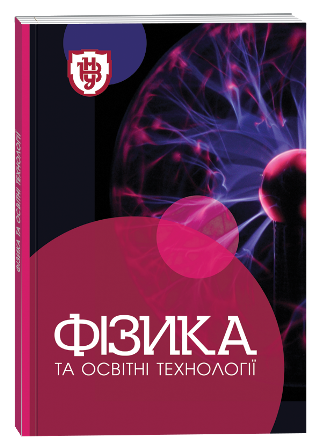PHOTOELECTRIC PROPERTIES OF In/CuInS2-ZnIn2S4 AND In–Ga/CuInS2-ZnIn2S4 DIODE STRUCTURES
DOI:
https://doi.org/10.32782/pet-2025-1-9Keywords:
semiconductors, surface-barrier structures, photovoltage, copper vacanciesAbstract
The paper presents the results of studies on the photovoltaic properties of surface-barrier structures based on monocrystalline CuInS2–ZnIn2S4 films. These structures were obtained using thermal vacuum deposition of semitransparent In films on the CuInS2–ZnIn2S4 surface and mechanical rubbing of In–Ga eutectic into the surface of monocrystalline CuInS2–ZnIn2S4 fractures. The semitransparent indium films were deposited by thermal vacuum evaporation in a VUP- 5 system at a pressure of 1,3×10-5 Pa and a temperature of 300 K. The surface area onto which the semitransparent In layer was deposited was approximately ≈3×3 mm².When illuminating the In/CuInS2–ZnIn2S4 structure with 8 mol.% ZnIn2S4 from the CuInS2–ZnIn2S4 side, a single well-defined maximum was observed. The energy position of the maximum in the photovoltage spectrum corresponds to the photon energy of hν≈1,53 eV. When illuminating the samples from the side of the semitransparent In layer, two maxima were observed with energy positions of hν≈1,44 eV and hν≈1,60 eV. Similar results were obtained for diode structures with 12 mol.% ZnIn2S4. In samples with 12 mol.% ZnIn2S4, when illuminated from the monocrystalline substrate side, a shift of the photovoltage maximum to 1,56 eV was observed, which correlates well with the increase in the band gap of CuInS2–ZnIn2S4 as the ZnIn2S4 content increases.The highest photovoltage values among the diode structures In-Ga/CuInS2–ZnIn2S4 were observed in structures with 12 mol.% ZnIn2S4. When illuminated from the semiconductor substrate side, a narrow maximum with an energy position of hν≈1,44 eV was observed. When illuminated from the In–Ga eutectic side, alongside the maximum caused by intrinsic optical transitions (hν≈1,68 eV), a less pronounced step was observed in the long-wavelength region. This step was attributed to impurity light absorption, primarily caused by VCu.Having narrow maxima in the photovoltage spectra, the In(In–Ga)/CuInS2–ZnIn2S4 structures can be used as narrow-band light receivers. The energy position of the maxima in the photovoltage spectra depends on the composition of the CuInS2–ZnIn2S4 monocrystals, the method of obtaining the bilayer structure, and the illuminated side of the structure.
References
Кудря С.О. Нетрадиційні та відновлювані джерела енергії. Підручник. Київ: Національний технічний університет України «КПІ», 2012. 495 с.
Кудря С. О., Будько В. І. Нетрадиційні та відновлювані джерела енергії [Електронний ресурс] : курс лекцій. Київ : НТУУ «КПІ», 2013. 387 с.
Klenk R., Klaer J., Scheer R., Lux-Steiner M.Ch., Luck I., Meyer N., Ruhle U. Solar cells based on CuInS2 – an overview. Thin Sol. Films. 2005. Vol. 509, P. 480–481.
Meese J.M., Manthuruthil J.K., Locker D.R. CuInS2 diodes for solar-energy conversion. Bull. Amer. Phys. Soc. 1975. Vol. 20. P. 696.
Bozhko V.V., Novosad A.V., Parasyuk O.V., Vainorius N., Vertelis V., Nekrošius A., and Kažukauskas V. Enhanced persistent photoconduction in CuInS2–ZnIn2S4 alloys single crystals and processes of its relaxation. Molecular Crystals and Liquid Crystals. 2016. Vol. 627. P. 153–162.
Bozhko V.V., Novosad A.V., Parasyuk O.V., Vainorius N., Vertelis V., Nekrošius A., Kažukauskas V. Photoconductivity relaxation processes in Cu1-xZnxInS2 solid solutions. Materials Science in Semiconductor Processing. 2015. Vol. 39. P. 665–670.
Bozhko V.V., Novosad A.V., Parasyuk O.V., Khyzhun O.Y., Vainorius N., Nekrošius A., Vertelis V., Kažukauskas V. Electrical properties and electronic structure of Cu1−xZnxInSe2 and Cu1−xZnxInS2 single crystals. Journal of Physics and Chemistry of Solids. 2015. Vol. 82. P. 42–49.
Новосад О.В., Федосов С.А., Божко В.В. Вольт-амперні характеристики поверхнево-бар’єрних структур In/ CuInS2-ZnIn2S4. Наукові нотатки. 2020. №. 69. С. 63–67.
Bozhko V.V., Novosad A.V., Davidyuk G.E., Kozer V.R., Parasyuk O.V., Vainorius N., Sakavicius A., Janonis V., Kazukauskas V. CuInS2-ZnIn2S4 solid solutions: Growth, physical and photo-electrical properties. Molecular Crystals and Liquid Crystals. 2014. Vol. 604, № 1. P. 164–173.
Bozhko V.V., Novosad A.V., Davidyuk G.E., Kozer V.R., Parasyuk O.V., Vainorius N., Sakavičius A., Janonis V., Kažukauskas V. Solid-state solutions of copper indium disulfide and zinc indium tetrasulfide: Growth, crystallography and opto-electronic properties. Materials Science in Semiconductor Processing. 2014. Vol. 24. P. 231–236.
Wagner S. Defect physics of the CuInSe2 chalcopyrite semiconductor Top. Appl. Phys. 1997. Vol. 17. P. 171–176.
Novosad O.V., Bozhko V.V., Kityk I.V., Vertelis V., Photoelectrical and piezooptical properties of Cu1-xZnxInS2 solid solutions. Sensor Electronics and Мicrosystem Technologies. 2015. Vol. 12. P. 53–62.








